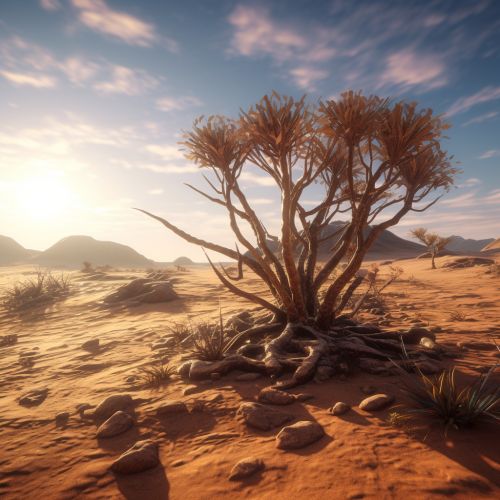Phreatophyte
Introduction
Phreatophytes are a type of plant that have adapted to arid environments by developing extensive root systems that tap into the water table. These plants are typically found in desert regions where surface water is scarce, but groundwater is relatively abundant. The term 'phreatophyte' comes from the Greek words 'phreato', meaning 'well' or 'spring', and 'phyte', meaning 'plant'.

Adaptations
Phreatophytes have evolved a number of unique adaptations that allow them to survive in arid environments. The most notable of these is their extensive root system, which can reach depths of up to 60 meters in some species. This allows them to access groundwater that is unavailable to other plants. In addition to their deep roots, phreatophytes also have a number of other adaptations that help them conserve water. These include thick, waxy leaves that reduce evaporation, and the ability to store water in their stems and leaves.
Distribution
Phreatophytes are found in arid regions around the world, including the deserts of North America, Africa, and Australia. They are particularly common in areas where the water table is close to the surface, such as along riverbanks and in areas with shallow groundwater. Some species of phreatophytes are also found in more temperate regions, where they can be an important component of wetland ecosystems.
Ecological Role
Phreatophytes play a crucial role in the ecosystems they inhabit. By tapping into the water table, they help to stabilize the soil and prevent erosion. They also provide habitat and food for a variety of wildlife species. In some cases, phreatophytes can also help to recharge the water table by slowing the rate of evaporation and promoting the infiltration of rainwater into the ground.
Human Use
Humans have made use of phreatophytes for thousands of years. Many species have edible parts, and have been used as a source of food in desert regions. Some species are also used for their medicinal properties, while others are used for their wood or as ornamental plants.
Threats and Conservation
Like many plant species, phreatophytes face a number of threats. These include habitat loss due to urban development, overgrazing by livestock, and changes in groundwater levels due to irrigation and other human activities. Conservation efforts for phreatophytes typically focus on protecting their habitat and managing groundwater use to ensure that these plants can continue to access the water they need to survive.
